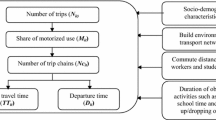Abstract
Researchers have used multiday travel data sets recently to examine day-to-day variability in travel behavior. This work has shown that there is considerable day-to-day variation in individuals' urban travel behavior in terms of such indicators of behavior as trip frequency, trip chaining, departure time from home, and route choice. These previous studies have also shown that there are a number of important implications of the observed day-to-day variability in travel behavior. For example, it has been shown that it may be possible to improve model parameter estimation precision, without increasing the cost of data collection, by drawing a multiday sample (rather than a single day sample) of traveler behavior, if there is considerable day-to-day variability in the phenomenon being modeled.
This paper examines day-to-day variability in urban travel using a three-day travel data set collected recently in Seattle, WA. This research replicates and extends previous work dealing with day-to-day variability in trip-making behavior that was conducted with data collected in Reading, England, in the early 1970s. The present research extends the earlier work by examining day-to-day variations in trip chaining and daily travel time in addition to the variation in trip generation rates. Further, the present paper examines day-to-day variations in travel across the members of two-person households.
This paper finds considerable day-to-day variability in the trip frequency, trip chaining and daily travel time of the sample persons and concludes that, in terms of trip frequency, the level of day-to-day variability is very comparable to that observed previously with a data set collected almost 20 years earlier in Reading, England. The paper also finds that day-to-day variability in daily travel time is similar in magnitude to that in daily trip rates. The analysis shows that the level of day-to-day variability is about the same for home-based and non-homebased trips, thus indicating that day-to-day variability in total trip-making is attributable to variation in both home-based and non-home-based trips. Day-to-day variability in the travel behaviors of members of two-person households was also found to be substantial.
Similar content being viewed by others
References
Golob TF & Meurs H (1987) A structural model of temporal change in multi-modal travel demand.Transportation Research 21A: 391–400.
Goodwin PB (1977) Habit and hysteris in modal choice.Urban Studies 14: 95–98.
Goodwin PB, Kitamura R & Meurs H (1990) Some principles of dynamic analysis of travel behavior. In: Jones P (ed)Developments in Dynamic and Activity-Based Approaches to Travel Analysis (pp. 56–72). Avebury, Aldershot: Oxford Studies in Transport.
Hanson S & Huff JO (1982) Assessing day-to-day variability in complex travel patterns.Transportation Research Record 891: 18–24.
Hanson S & Huff JO (1988) Systematic variability in repetitious travel.Transportation 15: 111–135.
Hensher DA, Smith NC, Milthorpe FM & Barnard PO (1992)Dimensions of Automobile Demand: A Longitudinal Study of Automobile Ownership and Use. Amsterdam: North Holland.
Huff JO & Hanson S (1986) Repetition and variability in urban travel.Geographical Analysis 18(2): 97–114.
Huff JO & Hanson S (1990) Measurement of habitual behaviour: Examining systematic variability in repetitive travel. In: Jones P (ed)Development in Dynamic and Activity-Based Approaches to Travel Analysis (pp. 229–249). Avebury, Aldershot: Oxford Studies in Transport.
Jones P & Clarke M (1988) The significance and measurement of variability in travel behavior.Transportation 15(1): 65–87.
Kitamura R (1990) Panel analysis in transportation planning: An overview.Transportation Research 24A(6): 401–415.
Kitamura R & Van der Hoorn T (1987) Regularity and irreversibility of weekly travel behavior.Transportation 14: 227–251.
Koppelman FS & Pas EI (1984) Estimation of disaggregate regression models of person trip generation with multiday data. In: Volmuller J & Hamerslag R (eds)Proceedings of the Ninth International Symposium on Transportation and Traffic Theory (pp. 513–529). Utrecht, The Netherlands: VNU Science Press.
Mahmassani HS, Hatcher SG & Caplice CG (1991) Daily variation of trip chaining, scheduling, and path selection behavior of work commuters. InSixth International Conference on Travel Behaviour: Methods for Understanding Travel Behaviour in the 1990's, Quebec, Vol. 2: 29–45.
Mahmassani HS & Herman R (1990) Interactive experiments for the study of tripmaker behavior dynamics in congested commuting systems. In: Jones P (ed)Developments in Dynamic and Activity-Based Approaches to Travel Analysis (pp. 272–298). Avebury, Aldershot: Oxford Studies in Transport.
Mannering F (1989) Poisson analysis of commuter flexibility in changing routes and departure times.Transportation Research 23B(1): 53–60.
Pas EI (1986) Multiday samples, parameter estimation precision, and data collection costs for least squares regression trip-generation models.Environment and Planning A 18: 17–27.
Pas EI (1987) Intrapersonal variability and model goodness-of-fit.Transportation Research 21A(6): 431–438.
Pas EI and Koppelman FS (1987) An examination of the determinants of day-to-day variability in individuals' urban travel behavior.Transportation 14: 3–27.
Sundar S (1992) Analysis of intrapersonal variability in individual travel behavior.Master's thesis, Department of Civil and Environmental Engineering, Duke University, Durham, NC.
Author information
Authors and Affiliations
Rights and permissions
About this article
Cite this article
Pas, E.I., Sundar, S. Intrapersonal variability in daily urban travel behavior: Some additional evidence. Transportation 22, 135–150 (1995). https://doi.org/10.1007/BF01099436
Accepted:
Issue Date:
DOI: https://doi.org/10.1007/BF01099436




